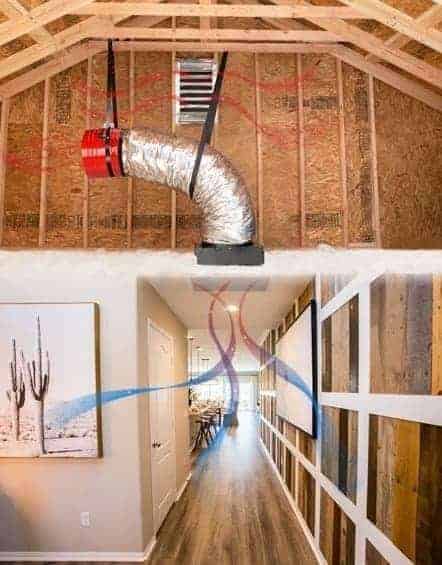Table Of Content
The sound level of an advanced whole house fan is very comparable to a normal A/C running in your home. Check out this graph to see a comparison in decibel levels of your most common in-home appliances and other things that make noise. This is accomplished by separating the motor housing away from your air register directly at the ceiling level. Remember that the old traditional style whole house fans that are very noisy are not comparable to the new, advanced whole house fans which can be over 40dB quieter. Advanced Whole house fans are the perfect pairing to create a net zero home. Watch our quick video that explains why every home needs an Advanced Whole House Fan system.
AC Infinity Airtitan T7 Wall-Mounted Ventilation Fan
Whether you need a rooftop or gable attic fan, we can offer the ideal solution for your cooling needs. In some situations, it makes sense for a home to have both an attic fan and a whole house fan. An HVAC professional can perform an inspection and help you decide what kind of ventilation system you need based on your home’s structure and location. Whole house fans keep the whole home cooler in the summer, but do have some drawbacks.
What Does HVAC Unit Replacement Cost? (2024) - Bob Vila
What Does HVAC Unit Replacement Cost? ( .
Posted: Mon, 15 Apr 2024 07:00:00 GMT [source]
The Best Wine Coolers and Wine Fridges for Chilled Drinks
If you’d prefer to operate a non-app-controlled fan via your smartphone, you can install a WiFi-enabled switch. Some fans have Wi-Fi connectivity so that they can be controlled via a smartphone app. With these fans, you don’t even have to be home to ensure the temperature in the house is comfortable. You can adjust fan speed, timers, and other settings directly from your phone. QuietCool’s ES-4700 might cost more than the company’s other units, but this series’ brushless direct-drive motors are efficient, quiet, and require minimal maintenance.
QuietCool ES-4700 Energy Saver Whole House Fan
Advanced Whole House Fans can be an effective and energy-efficient way to cool a home, especially in places with mild climates. But it’s important to remember that Advanced Whole House Fans are not the same as air conditioning and may not work in very hot or humid weather. Open windows throughout the house to prevent a powerful and concentrated suction in one location. An attic fan works by exchanging the hot air in your attic space for fresh air pulled through the vents. This will help avoid premature damage to the shingles or mold in moist, hot attics.
Keeping a house cool and well-ventilated is important for its residents' comfort and the house's health. Attics must stay dry and climate-conditioned to prevent mold and ice dams from developing on the roof. Read on to find out if an attic fan is the best solution for you and look at its pros and cons compared to a whole house fan. Our Smart Attic Fan Series offers your home a healthier attic, a cooler place to live, and a reduced A/C bill.
Quietcool QC CL-3100 Whole House Fan
85% said they were either "thrilled" or "very satisfied" with their AirScape purchase. Drill the holes for the saddle brackets, and mount the fan to the ceiling joist. The Bob Vila team distills need-to-know information into project tutorials, maintenance guides, tool 101s, and more. These home and garden experts then thoroughly research, vet, and recommend products that support homeowners, renters, DIYers, and professionals in their to-do lists. Enlarge your attic venting by adding dormer vents, eave vents, ridge vents, soffit vents, or turbine vents. You can protect your home’s health by reducing the risk of mold and mildew build-up in your attic all while keeping your home cool and your A/C bill low.
Whole-House Fans Remain Part of Creating Comfort - ACHR NEWS
Whole-House Fans Remain Part of Creating Comfort.
Posted: Mon, 24 Aug 2020 07:00:00 GMT [source]
Product costs, availability and item numbers may vary online or by market. Save up to 50-90% on A/C related costs so you can get a return on your investment in as little as 1-2 years. At just 45 pounds, it's lighter than comparable models, although you’d still want a friend to help when it comes to hanging the ductwork.
Install the Mounting Brackets
There are four main types of whole house fans, including traditional, insulated joist-mount, ducted, and roof-mounted. You can, but models with accessible fans are usually pretty affordable to replace entirely. If you do want to replace the motor, bring it to an electrical shop, and they should be able to match you up with a new one.
How We Chose the Best Whole-House Fans

Using our Smart Control App you can set presets, turn on and off whenever you need, and see the exact temperature and humidity of your attic space. Alex Rennie is a freelance writer who specializes in the Home Improvement, DIY, and Tool space. As a former residential and commercial carpenter, Alex uses his hands-on experience to write practical buying guides, how-to articles, and product reviews.
You’ll want to understand the different capabilities and functions of models as well as the material they are constructed from. And, most importantly, there are some safety considerations to remember before setting out to install a new attic fan. Buyers will appreciate that this gable vent fan can be installed through an exterior wall instead of a hole in the roof. It’s also constructed of sturdy galvanized steel, so it should be durable against moisture for a long time.
Gable fans are installed at the very top of your gable-end walls and vented through the walls outside. Whole-house fans require cutting through the finished ceiling on the highest floor of your home and ventilating outside. If a whole-house fan doesn’t have the proper ventilation, it won’t work very well either. It’ll fill the attic with hot air, stopping it from pulling more air into the space through open windows.
For folks who’d prefer a cooling method that draws less on the energy grid and provides a bit more fresh air, the best whole-house fan might be the way to go. Passive attic fans rely on natural processes like wind or pressure to circulate air. Whole house fans are typically positioned in the attic, where they can draw the warm air out of the main part of the home and vent it outside. However, if the home doesn't have an attic, then it becomes significantly more difficult to install a whole house fan. Depending on where you live, your home’s construction and your A/C habits, an AirScape whole house fan can reduce your cooling costs up to 50-90%.
Also, since Advanced Whole House Fans only require a few windows to be open, homeowners do not need to replace every screen in the home! You use them primarily during the day but they work well in the evening and night as well. Attic fans pull air from the outside through existing vents in your attic. This allows your attic to stay within 10ºF of the outside temperature at all times when the fan is running.
The fan itself is on the far end of the duct, minimizing noise in the living space. Vented into a large attic space, you probably won’t even notice that this fan is running. For folks with access to their attic’s gables, iLiving’s gable-mount attic fan is a great option for moving air without cutting a hole in the roof. This model can be installed through the wall and capped outside with a vent cover to keep out pests and the weather. Cubic feet per minute (CFM) and square footage covered are also important when choosing an attic fan. As such, the options above are made for small or large spaces with 537 to 3,126 CFM ratings.
Some folks may want to purchase a separate thermostat to shut the fan off when it’s not needed, preventing it from burning out prematurely. Homeowners looking for a through-the-wall gable-style attic fan with all the bells and whistles should check out the AC Infinity Airlift T14. This high-tech attic fan features steel and aluminum construction, ensuring it can hold up to the rigors of attic ventilation. It produces up to 1,513 CFM, making it suitable for medium-size attics and even slightly larger spaces. Shutter-style attic fans that replace existing gable vents cost $200 to $400.

No comments:
Post a Comment